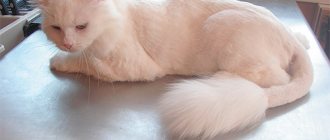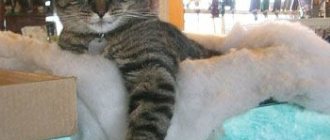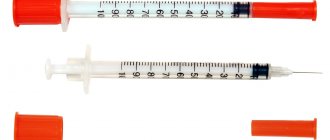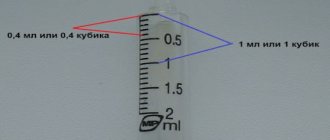Every cat has to take medication at least once a year before routine vaccinations. Getting an animal to eat a pill is not an easy task. Cats are acutely aware of any dirty tricks; they hide and refuse food if it contains any unpleasant impurities.
It is important for pet owners to know how to give their cat liquid medicine from a syringe or in dry form and to be able to resort to certain tricks.
Basic scheme
1. Prepare a syringe with medicine.
The liquid medicine is given in a syringe without a needle.
The syringe is usually calibrated in milliliters. Remember that 1 milliliter is 1 cubic centimeter. A teaspoon will contain about 5 milliliters of liquid.
2. Fix the cat.
You need to take the cat on your lap so that she cannot scratch you. You can wrap the cat in a blanket or towel and open its mouth slightly. To do this, place your thumb and thumb behind the fangs and push the cat's jaw apart.
It is important that the cat's head is raised up when swallowing, otherwise she will spit out the medicine by shaking her head. The head should not be thrown back, otherwise the cat may choke. Fixation of cats
3. We give medicine.
Then place the syringe in the corner of the cat's mouth behind the fang.
Slowly pour the contents of the syringe into the side of your throat. There is no need to rush - the animal may choke. Inject no more than a milliliter of solution at a time, about a quarter of a teaspoon, and allow the cat to swallow in between to prevent it from choking.
When the medicine in the syringe runs out, close your cat's mouth. Wait, she must swallow everything, otherwise the cat may simply spit out the medicine. If after this you remain unharmed, you can stroke the cat's neck towards the esophagus. This stroking helps to swallow the medicine.
4. Calm the cat.
If possible, after the procedure the cat should be calmed, petted and given treats.
How to give medicine to a cat mixed with food
The easiest and safest (for humans) way to properly give medicine to a cat is to crush the tablet and mix it with the cat's food. This works great in some situations.
What's important here is:
- carefully grind the tablet to a powder, leaving no large pieces (the cat will pick them out from the food and will not eat them);
- mix the medicine with food of liquid or semi-liquid consistency to obtain a homogeneous mass;
- choose fragrant and favorite food for the cat in order to mask the taste and smell of medications as much as possible.
The catch is that the cat may refuse its favorite food if it smells the chemical smell of the pills. But it's worth a try. It goes without saying that this option is absolutely not suitable, since the drug must be taken on an empty stomach.
Emotional mood
One of the mandatory conditions for treatment is to take care of the animal’s emotional state in advance. Before giving a pill to a kitten or adult pet, try to behave calmly and not be nervous. You can simply talk to the animal - the owner’s voice has a calming effect. It is not recommended to chase your pet throughout the apartment; it is better to wait until it comes on its own. It is prohibited to carry out the procedure near the sleeping area, tray or food bowl. Subsequently, the animal will associate them with unpleasant manipulations.
Another requirement is not to call the cat to take the medicine. The animal may decide that the owners are going to feed them, play or just pet them. In the future, the pets will refuse to respond to their owners’ calls.
You should not force an animal to take medicine, especially if a long course of treatment is prescribed. Each time it becomes more and more problematic to give a pill to a cat, so it is recommended to perform manipulations only on a pet that is in a state of calm. If your pet behaves aggressively or restlessly, it is better to postpone taking the drug for a while and repeat after an hour and a half.
X
How to give the suspension
Giving a suspension to a cat is no easier than giving tablets, since in no case does it want to swallow what a caring owner offers it. She begins to salivate excessively. On the face you get a whole beard from the medicine.
- To give your cat or kitten a suspension, you can try mixing it with your pet’s favorite food: pate, minced meat, sour cream. This must be done with a small amount of food in order to accurately control the dose of the drug eaten.
- Everyone knows that cats are very clean animals. The anti-worm suspension can be spread on your pet’s paws. He will diligently begin to lick them. This way he will lick the entire dose of the drug and save both himself and the owner’s nerves.
How to feed a kitten with a syringe: methods, portions, food, regimen
Feeding a kitten is the cat's responsibility. But what to do in cases where the parent is not around? Then the person has to take on the responsibilities of a mustachioed mother and feed the kitten on his own. There are many ways to feed a cat, but one of the simplest and most popular is to syringe feed the kitten.
Employees of the Murkosha shelter often encounter feeding kittens, since there are too many abandoned animals on the streets. Therefore, we can confidently say that this is a simple and effective method.
Read more: “How to feed a kitten on your own?”
Which syringe to choose for feeding?
Syringes are used to feed not only kittens, but also adult cats. This happens in cases where the animal is sick and weakened so much that it cannot eat solid food on its own. This is why veterinary pharmacies sell special syringes for feeding. However, if you can’t buy a tool, you can use a regular medical syringe with a capacity of 10 milliliters or more. Of course, you first need to remove the needle from it.
How to prepare an animal for feeding?
Even a small kitten may try to dodge or run away. Therefore, before you start feeding, you need to fix it. To do this, the baby is carefully wrapped in a towel and placed so that he cannot move. The main thing is not to pinch his paws or put pressure on his organs.
But these methods are used if the animal behaves aggressively. When we are talking about a calm or very small kitten, it is necessary to arrange for it a feeding place that will resemble a mother cat. Cuvettes are often used for this purpose. The bottom is covered with soft fabric, folded several times. The kitten is placed inside so that it can rest its hind legs on the floor and its front legs on the side of the ditch. The cat is held by the back with one hand, and the other is placed on the side. This method is as safe as possible, since the kitten cannot be dropped and injured. Kittens really like this feeding because they can massage the tissue with their paws and take the position in which they usually suckle their mother cat.
Feeding process
No matter how much the kitten dodges the syringe, he actually wants to eat, so as soon as the baby feels the taste of food, his appetite will immediately awaken. The main task for the owner is to force the pet to take the first sip. To do this, you can bring the syringe closer to the nose, and if the kitten smells it, it will most likely open its mouth. Then you need to quickly drop a little food onto your tongue, and then lift its head and stroke it along the throat in the direction of the esophagus. In this way, the owner will trigger a swallowing reflex in the animal, and it will eat part of the portion.
Sometimes it happens that a kitten or an adult cat flatly refuses to touch food. Then the owner has no choice but to force-feed him. Yes, the animal will be a little uncomfortable, but it is worth reminding yourself that all this is being done for its benefit. This has happened more than once at the Murkosha shelter, both with babies and adult cats. Therefore, our volunteers know well how to get animals to eat, because without food they quickly weaken, can get sick and even die.
To feed a kitten with a syringe, you need:
- Open your mouth slightly;
- insert a syringe (you need to aim at the cheek or palate, but not at the larynx);
- squeeze out a little mixture (no more than one-fourth teaspoon);
- wait until the cat swallows the food.
During feeding, it is necessary to ensure that the kitten's head does not tilt back too much and that food does not get into the respiratory tract. Many owners feel sorry for their animals, and they stop feeding as soon as the kitten starts to struggle. In such situations, you need to remember that without food the pet will disappear, and continue.
What to feed a kitten?
For feeding, veterinarians recommend using a special milk formula, which is sold in veterinary pharmacies. This analogue of cat's milk contains all the substances necessary for the proper development of a newborn kitten. In addition, after eating this food the baby will not have an upset stomach.
If the mixture cannot be found, you can use cow's milk with the addition of a small amount of protein. Formulas are also sometimes used for newborn babies. They are really suitable for kittens, as long as the jar is marked 1-2 weeks old.
How much food should a kitten eat?
Portions are determined depending on the age and weight of the cat. Below we provide a small list of proportions (the amount of food is taken per 100 grams of animal weight):
1-4 days – 30 ml;
5-13 days – 38 ml;
14-24 days – 46 ml;
25-35 days – 53 ml.
How can you tell if your kitten is no longer hungry?
The babies are fed in two stages, since after the first saturation the kittens usually want to go to the toilet. Therefore, it is necessary to let the animal do its business, and only then continue to feed it.
At the first stage, cats absorb food very intensively, eating a large amount. Then they eat much less. A sign that the cat is completely satiated is that he sucks the syringe more sluggishly, and then completely falls asleep. If the animal is healthy and shows an appetite, it should not be fed more than it wants. It is worth remembering this, and when the baby falls asleep, do not feed him, but leave him to rest.
Feed temperature
As is the case with small children, kittens should not be fed hot formula, as it can harm their still fragile stomach and esophagus. Therefore, before starting feeding, you need to check the temperature:
- 1 week – 38-39'С;
- Week 2 – 30-32'C;
- 3 week – 28-30'C;
- Week 4 – 24-26'C.
It is very easy to determine the temperature - before feeding, the syringe is applied to the forehead or the skin on the bend of the elbow. If it has a normal temperature and does not seem hot, then you can start feeding the cat.
How often should kittens be fed?
In order for the animal to grow healthy, not to overeat and not to starve, it is important not only to choose the right mixture, but also to develop a feeding scheme. In the first two weeks of life, kittens are fed very often - every two hours. When a week passes and the animals grow a little, the interval can be increased to three hours.
A kitten at the age of one month should eat once every four hours, and already in the fifth week of life it can be switched to two meals a day and add special canned food designed for mustachioed babies.
Remember that taking home a kitten is the same as having a small child, who vitally needs routine, education and careful care - all this requires a lot of free time. Therefore, before taking a baby from a shelter, you need to think carefully about everything.
Read more: “Cat or kitten - who to choose?”
At Murkosh, we adhere to the correct diet and give babies only specialized formulas for kittens, and in addition, our team provides the animals with qualified care almost 24/7. We will be happy to hand over a wonderful baby into your caring hands if you become the most responsible owner for him.
How to give anthelmintics to a kitten
A kitten can only be given anti-worm medication from three weeks of age. After the first deworming, it is necessary to repeat the procedure 10 days later.
As a rule, it is easier for a kitten to carry out such activities than for an adult animal.
- The medicine in tablet form can be crushed to form a powder, which should be carefully poured from a piece of paper into the baby’s mouth. It is better to keep the kitten on your lap while lying on its back.
- Second option: the tablet is diluted with a small amount of water. Give from an insulin syringe, from which the needle must first be removed.
- It is easier to administer the suspension to a kitten together. One carefully holds the baby so that he does not twitch. And the second, raising his upper lip, gradually injects the medicine from the side. Then you need to stroke the animal’s neck from top to bottom.
What is important to consider when giving your pet medication?
Giving tablets, capsules, powders and mixtures seems much easier than giving a cat an injection. In reality, everything is not so simple. A cute pet will definitely remind you that it has teeth and claws.
Giving medications orally (orally through the mouth) must be done correctly:
The best position for administering the drug is when the animal is sitting or in the sphinx position. This reduces the risk of medications entering the respiratory tract. Crushed pills and powders should not be poured dry into the animal’s mouth.
High risk of suffocation. It’s a good idea to ask your veterinarian whether a certain drug can be given with food, dissolved in a liquid, or ground into powder. It is important to monitor the dosage. Especially in kittens, who are often prescribed a certain proportion of one tablet. It is strictly forbidden to give liquid medicine to cats lying on their back. When a cat is given a bitter or sour drug, foam may form in the mouth and excessive salivation may occur.
It's not critical. But next time it is better to choose a different method.
You cannot give your pet suspensions, solutions, dragees, capsules, syrups, mixtures on your own in the following cases:
- vomit;
- difficulty breathing;
- damaged neck muscles and skull bones;
- intestinal obstruction, constipation for many days, when there is a risk of complete blockage of the intestine or when a foreign body is suspected;
- painful lesions in the oral cavity.
Is it necessary to give the pill to a cat?
First of all, ask your veterinarian whether it is necessary to give your cat the pill in its “pure” form.
Here is a list of questions that your cat will thank you for:
- Can I mix the tablet with food?
- Can the tablet be dissolved in water?
- Is it possible to grind a tablet into powder?
If the vet says yes, you're in luck. Otherwise, get ready for a difficult test, because some drugs cannot be mixed with food or water. You will have to force the cat to swallow the pill and not spit it out.
Gently bring the syringe to the corner of the animal's mouth
This technique will force the cat to spread its jaws. Hold the syringe so that the medicine is applied to the back of the tongue on the side, rather than directly into the throat, which may cause gagging.
It's worth noting that some veterinarians recommend allowing your cat to lick the tip of the syringe first so that the taste of the medication doesn't scare it off. If you are unsure about the correct technique, consult your veterinarian.
What to feed a sick cat
In the advanced stage of any disease, the cat refuses to eat. There can be many reasons: loss of strength, nausea, pain during chewing, loss of smell, lack of a swallowing reflex, injury or inflammation of the throat, etc. Hunger quickly leads a cat to exhaustion, and if the pet still doesn’t drink, then to dehydration.
Feeding a sick cat requires an individual approach , since you need to clearly understand the needs of the body and adapt to them. Without permanent consequences, a cat can fast for 24 hours, but a noticeable slowdown in metabolism will occur after 12 hours.
Note! A slowdown in metabolism leads to less production of leukocytes and a decrease in the body’s cleansing function... in other words, loss of strength and progression of the disease.
Almost always carbohydrates , since, while fighting the disease, the pet loses weight. It is important not to overdo it, since the body also wastes energy not processing carbohydrates. To help your pet you need to provide him with the most comfortable conditions, warmth and eliminate the need to move around his home.
The type and method of nutrition is selected taking into account the maximum number of consequences of the disease. The minimum that needs to be taken into account is:
- Weakened intestinal microflora - almost always, if a cat has a fever, colonies of friendly bacteria die en masse. Visually this is not noticeable, but the consequences will not take long to appear - the cat will have indigestion. Conclusion - food should be easy to digest.
- Exhaustion - the body of a sick cat throws all its resources into fighting the disease, so the fur, skin, and some mucous membranes are left without the usual nutrition. Conclusion - food should be nutritious.
- Irritation of mucous membranes - in cats, the mucous membranes of the eyes, nose and mouth interact almost instantly, that is, if the eyes, throat and throat are irritated. Many pets refuse to eat simply because they have difficulty swallowing. Conclusion - food should be warm, liquid or crushed and soft.
How to give a pill manually
Thank you for watching!
If you liked the video, share it with your friends:
If your cat will not take the tablets voluntarily or with food, you will need to give the tablet manually.
The easiest way to give cats a pill is to use a special device - a Pet Piller. They are produced in different modifications, but essentially they are designed the same - the tablet is attached to the tip of the device and is pushed out of it by a piston, as in a regular syringe. Pillers come in different lengths and are designed for different sized tablets, but you can easily figure out which one is suitable for your cat. If you couldn’t get the piller, you will have to give the pill to the cat “manually.”
An easy way to “restrict freedom” will allow you to do this safely if it involves the participation of two people - one will hold the cat, and the other will administer the tablet orally. But often you have to do this yourself without the help of anyone. In this case, use a towel for safety and restrict freedom of movement as shown in the pictures.
Showering with a catheter and urine bag
It is important to maintain good body hygiene by showering regularly. This reduces the risk of infection. Before standing under the stream of water, the urinal is disconnected and the catheter is clamped with a special clip. When washing, you should gently wash the genitals around the catheter using baby or liquid soap with a neutral pH.
After bathing, the catheter tube is carefully dried, the genitals are blotted with a soft cotton towel, and a clean urine bag is put on. You can swim every day, following these rules.
How to flush a Foley catheter at home
You can use a weak solution of potassium permanganate (1:10000), “Dioxidin”, which is diluted with water 1:40 or “Furacillin” (1 tablet 0.1 g per 100 ml of liquid). It is possible to rinse the catheter with Miramistin, a ready-made pharmaceutical solution, or a product recommended by the doctor. The rinsing is carried out in such a way that the patient does not experience pain or discomfort.
It is important to wash your hands thoroughly and use a sterile syringe with which the solution is delivered. The urinal is disconnected from the tube, and the end is treated with antibacterial solutions. Then attach a syringe, which slowly delivers the rinsing solution. You need to first apply about 20-30 ml, after introducing the liquid into the bladder, the syringe is disconnected. It flows back on its own. The rinsing is repeated three times, then the urinal is reattached.
When to use a syringe
A cat will swallow liquid medicine faster than a tablet or powder. But more often the animal does not like the taste. Then you will need a syringe. If the cat is calm, then instead of a syringe, a large pipette will be enough. But it was not possible to gradually pour the medicine from the pipette.
The cat should be held on your lap, but it should not lie down - just sit. There is no need to open your mouth: just stick the syringe behind your cheek. You need to raise your head slightly, but not throw it back.
How to give medicine from a syringe
The medicine is administered slowly so that the cat has time to swallow it. During this procedure, you must ensure that the liquid does not enter the windpipe: to do this, at the moment of inhalation, you must stop the infusion of the solution. But if the cat still swallows the liquid incorrectly and coughs, the procedure must be stopped: calm the animal, let it cough, and only then continue.
If the veterinarian allows it, then it is better to dilute the medicine with water or milk to discourage the unpleasant taste.
Since holding a pet and administering medicine at the same time is difficult, it is better if someone assists - holding the cat on their lap.
Psychological moment
If the tablet needs to be given once, there will most likely be no problems. Difficulties begin when the cat is prescribed a course of treatment, and the procedure has to be repeated daily.
The cat will quite quickly (from the first time) develop a panic reflex at the sight of a package with the drug, which will make each subsequent administration more and more difficult.
To avoid putting your animal under constant stress, hide the pills away and try to do the manipulations quickly. If the drug allows you to combine the tablet with food, then treat your cat with tasty food at the end. Let salivation replace the fearful reflex.
AVZ medicines for oral use
The AVZ company produces a wide range of medicines for animals, including in liquid form. In our catalog you will find the following types of drugs:
Anthelmintic
The liquid form of anthelmintic drugs is suitable for treating animals of different ages, weights and genders. The suspensions presented in the catalog (“Febtal combo”, “Dironet suspension”, “Dironet junior”) have a wide spectrum of action and can be used for cats and kittens.
Herbal remedies
Sedatives for cats, such as Fitex, are necessary, for example, during a long trip, a change of environment or other stressful situations. In addition to plant-based sedatives, the catalog provides drops for animals suffering from urolithiasis - Urolex. They have a beneficial effect on the functions of the kidneys and excretory system.
Regulation of the reproductive cycle
When used correctly, "EX-5", "EX-7.5" stop estrus or prevent it. The use of these drugs requires strict veterinary control.
How to open a cat's mouth and give medicine
After this, you need to carefully open the animal’s mouth with your own hands. To figure out how to open your cat's mouth to give medicine, apply gentle pressure to her cheeks. Do not use any physical force; the bones in a cat's jaw are very fragile.
When the cat wants to swallow, he will open his mouth, and then you need to hold it open with your fingers. After this, you should place the tablet on the root of the tongue or pour the suspension into the cat’s throat through a syringe (without a needle, of course). Many companies include special drinking syringes with their medications.
Do not let go of the cat right away, hold him in your arms and make sure that his mouth is closed (you can hold it with your hand). This is necessary so that the pet swallows the medicine and does not spit it out immediately.
In how to properly give medicine to a cat, the most important thing is not to damage the animal’s pharynx or oral cavity. Since the pet usually breaks away and turns its head, this is not easy to do.
Be extremely careful and precise in your movements. Many instructions on how to give medicine to a cat (videos and stories from experienced cat owners) suggest turning to your household for help. Alternatively, have someone hold the cat while you open its mouth and administer the drug.











